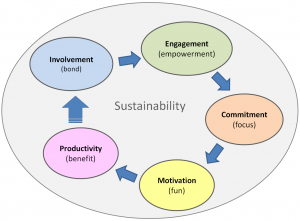The golden (broken) management approach
Golden and broken doesn’t certainly sound great concerning anything, but the management approach I going to write about should definitely ring some bell to your attention as a matter of real working scenario in organizations and teams. The golden part is about how it should be according to latest neuroscience discoveries applied to leadership and people management (and to common sense as well); the broken part is all about how actually often it is, the hard and sad reality of a pattern which doesn’t stop appearing again and again, but yet people easily fall on it or fail when seeking improvements.
What is the real problem? We forget that products, projects and processes are made of people, involve people and need people. Yes, people are gold. Therefore, my golden pattern of management involves people through several steps, each of which promotes a certain value and plays an important role in the whole chain. You might argue about ordering indeed, but the following elements should always be part of your leadership attitude:
- Involvement: we need to create a bond between our shared goal and the team, toward the same direction and involving every member as part of a whole, with transparency and openness.
- Engagement: we need to engage people with responsibilities and participation, empowering them. And you can’t engage people if you didn’t involve them.
- Commitment: we want commitment, because it brings focus and trust. But can you pretend commitment if you previously didn’t involve and engage?
- Motivation: people need motivation, as source of energies and continuity. And motivation would not suddenly appear and would certainly not last forever. It’s a daily effort, which indeed can flourish from the aforementioned points.
- Productivity: we want productivity, because after all we need to deliver some benefit to the supporting organization, but you need solid basis otherwise pressure and demand may easily burn your team.

The direct and main advantage of this approach is to preserve and support sustainability, which should always be a key target of any management. But admit it: it all sound common sense, however it rarely is common practice. Why? We can observe and predict the broken version of this pattern over and over, often due to one or more than one of the interconnected reasons below:
- Underestimation: sadly, we are aware of this pattern, but we underestimate its importance in the name of standard (and very old) organization management.
- Postponement: we really want to put it in place, to slowly coach and spread a certain direction, but we postpone it for the next product version, next quarter, next year, eventually next life.
- Workload: as usual, in busy time there is hardly a chance for a change, our endless list of tasks and priorities doesn’t allow additional or non foretasted activities.
- Immediate benefit: we need to perform successfully in the short term, so we don’t or we can’t really pay attention to the long run. Accordingly, the long run will likely be a copy of the short one.
- Corporate management: the global strategy and mentality definitely affects lower management and approaches. You can blame your direct leader, but what about the whole system? For instance, the HR departments too often end up in administration routines, completely absorbed and focused on the ‘R‘ part of their name. Hey, what about the ‘H‘?
And that’s why we got a broken pattern, which is golden indeed in its definition and presentation, but we repeatedly fail on its appliance, in the best case (because we supposedly knew about it). What happens then? Well, nothing different then daily working life: talented people may just leave, because of frustration and not enough motivated (lack of involvement? lack of engagement?); senior profiles may feel downgraded to junior roles (lack of responsibilities? Commitment? coding-monkey feeling?); weak team performances, burnouts, fear of speaking or sharing thoughts and figures, and so on.
Can we fix that? Of course we can, but watch out: you may easily fall in the typical honeymoon effect starting enthusiastic and truly convinced about it, then slowly regressing to the old and cosy behaviour. There isn’t any magic solution, it’s a (new?) strategy and approach to commit to and apply, it would take time but it’s an investment in sustainability and benefit, for companies and employees. And it is worth the effort.




